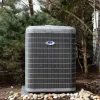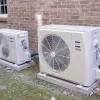When they’re done right, HVAC zones can seriously improve indoor comfort. Zones provide more control over the temperatures in different parts of your home, so you can dial in the perfect temperatures anywhere, anytime.
If you’re not familiar with zoning, it’s when you partition different areas of your house for heating and air conditioning. A common setup in two-story homes is to have two zones: one for upstairs and one for downstairs. Only need to heat your upstairs bedrooms at night? Set the thermostat to 67 for your upstairs zone and 62 for the downstairs. Then you can reverse the two the next morning.
Of course, you can have as many zones as you want to depend on your home’s floor plan and size. The benefits of a proper zoning setup include:
- More control over indoor comfort
- Even temperatures throughout your home
- Lower energy costs
Those are all good things! Unfortunately, there’s a catch.
Many zoned systems have major problems
Zoning an existing HVAC system isn’t always straightforward. In the absence of key modifications, splitting your system into zones can easily create problems that negate the benefits of zoning.
And even if you’re willing to get new HVAC equipment that accommodates different zones, you have to be sure you’re getting the right type.
Ok, so what does a dual fuel HVAC system have to do with zoning?
Before we answer that question, it helps to understand the problems with many zoning setups. We encounter lots of poorly designed zoning arrangements in residential HVAC systems throughout the Atlanta area, most of which have these attributes:
- The HVAC system is the right size for the whole house, but it’s way too big for just a section of the house (a single zone).
- To address that problem, the installers put in a bypass duct. Instead of trying to push a huge amount of air into a single zone — a scenario that leads to excess static pressure and overworks the system — a lot of conditioned air gets dumped back into the return side of the system.
This setup gets you the zones you want, but there are costs.
In summer, the system sends a lot of cold air back into the air conditioner, which increases your risk of freezing the coil. In winter, the excess heat ends up radiating back into your house anyway, negating a lot of the benefits of having zones. You also lose out on energy efficiency improvements since the system runs at full capacity even when you only need it to heat or cool one section of your house.
The solution to this problem — and we wrote a whole article about this! — is to always use variable speed HVAC equipment for zoned systems.
And if you get a dual fuel variable speed system, that’s even better.
Variable speed and dual fuel zoning advantage
First, let’s get a couple of definitions out of the way:
- Variable speed HVAC system: A heating and air conditioning system that can increase or decrease capacity to meet a home’s precise heating or cooling needs. Standard systems only run at full capacity every time they turn on. Variable speed systems ramp up and down, depending on the thermostat setting.
- Dual fuel HVAC system: A heating and air conditioning arrangement where an electric heat pump heats the home on cool days and a gas furnace heats the home on the coldest days. Heat pumps are generally more efficient than furnaces, but only to a point (and this depends on the current price of gas, of course). When the heating load is high, a gas furnace is usually more efficient. Dual fuel provides best-of-both-worlds efficiency.
In a zoned system, the advantage of variable speed equipment is pretty easy to understand. Since the system is capable of ramping up or down, it’s more than capable of only sending a small (and appropriate) amount of air to a single zone. You won’t have to install the clunky and problematic bypass duct described above because the system performs properly even when a single zone is the only one that needs heat or AC.
But what about dual fuel?
Well, heating with a dual fuel system is usually going to be more efficient than heating your home only with a gas furnace. Variable speed heat pumps, in particular, are very efficient on those cool-to-kinda-cold days in fall and early spring.
So if you’ve got a zoned system with all-variable speed dual fuel heating, you get the advantages of:
- Heat pump and furnace systems that can easily accommodate smaller HVAC zones with no comfort or efficiency penalty
- Ultimate efficiency all throughout the heating season whether the heat pump or the furnace is running
But even if the heat pump side of your dual fuel system isn’t a variable speed unit, a dual fuel system is still better for zoning.
Heat pumps provide less heating capacity, which is better when you have zones
Let’s say it’s the week before Thanksgiving. It’s cool outside, and you’ve got the heat turned on.
During the day, you only need heat in one zone of your house: the zone for the kitchen and living room. If you use a standard 60K BTU furnace for all of your heating needs, the furnace will run at 80% of 60K BTU even when you only need heat in one zone. There’s a good chance it’s going to overheat the zone, leading to uneven temperatures. The furnace is just way too powerful for such a small area!
Now pretend you have a dual fuel system instead. Since you can pair a 60K BTU furnace with a 36K BTU heat pump, the lower capacity of the heat pump allows it to do a better job of heating the small kitchen-living room zone. The heat pump will run for longer cycles, ensuring more even temperatures, and is less likely to send too much air through the system.
This is true even when you have a standard heat pump. A dual fuel system with a variable speed heat pump is definitely better for zoning because it can ramp down capacity to match the needs of the zone needing heat. However, even a standard heat pump works better with zones compared to a standard furnace on its own.
Basically, the presence of zones means you want an HVAC system that’s capable of operating at a reduced capacity. Otherwise, you may be dealing with bypass ducts, excess heat, a frozen AC coil in summer, and all of the complications we mentioned earlier.
But wait! What if I’ve got a variable speed furnace?
Then you’re a lot better off than someone with a zoned single-stage furnace! However, you’d still be in an even better situation with a variable speed dual fuel system. Let’s consider why.
Nearly all variable speed furnaces actually have a two-stage gas valve. So if you have a 60K BTU variable speed furnace, the furnace has two heating capacities: 48K BTU and 34BTU (remember, furnaces don’t operate at 100% efficiency). A variable speed heat pump, on the other hand, can ramp up and down between 9K and 36K BTU! This gives you a much broader range of efficiencies than even the variable speed furnace.
Even a 60K BTU variable speed furnace with a modulating gas valve (so not the two-stage kind) can only ramp down to 23K BTU. So having a dual fuel system in a zoned design with a variable speed heat pump is still better than only having the best-of-the-best variable speed furnace.
Thinking about adding zones to your HVAC system?
We can help you figure out what, if anything, you should modify to make sure the zoned system works properly!
If you live in Metro Atlanta and are considering adding zones to your HVAC system, get in touch with us! We’ll come and look at your existing system, determine whether it can accommodate zones, and provide our recommendations for getting the most out of your AC and heating system.






